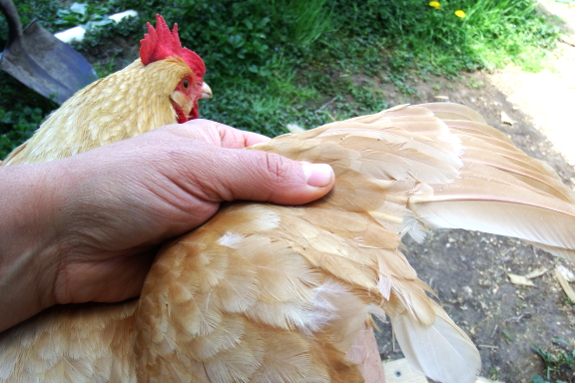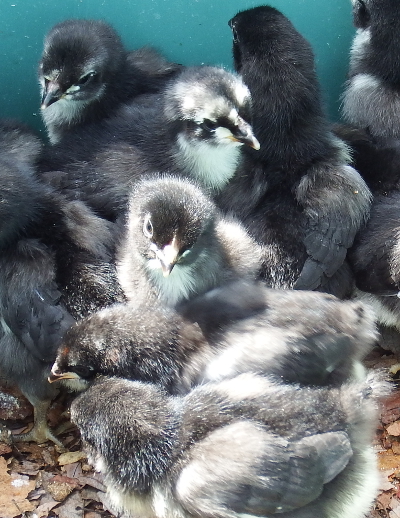
The downsides of experimentation

After some experimentation, Mark and I settled on Black Australorps
as the breed that best fits our farm. But then last spring I thought to
myself, "I'd really like to try a few more types of chickens that I've
never raised before." And so a mixed flock of Australorps, Buff
Orpingtons, Dominiques, Rhode Island Reds, and New Hampshire Reds showed
up on our farm.
 The
new breeds drive me nutty. Dominiques are so flighty...that they end up
in the garden. Buff Orpingtons are so people-oriented...that they end
up in the garden. Rhode Island Reds --- well, I'm not sure what they
are...but they end up in the GARDEN.
The
new breeds drive me nutty. Dominiques are so flighty...that they end up
in the garden. Buff Orpingtons are so people-oriented...that they end
up in the garden. Rhode Island Reds --- well, I'm not sure what they
are...but they end up in the GARDEN.
We put three bad hens in
the tractor last fall to deal with that issue, then I pushed everyone
else into the woods where they mostly behaved for the rest of the
winter. Now that I'm turning the flock back onto pasture, though, renegades are getting clipped. In case you're curious, the two renegades so far have been a Dominique and a Buff Orpington.
Which is the long version of why a box of layer chicks
came in the mail last week and the birds inside all looked exactly the
same. While it's probably unfair to the New Hampshires (who have yet to
cause any problems), I've decided to stick to the breed that has proven
itself multiple times over the past decade --- my favored Australorps.
Homesteading word to the wise: if it ain't broke, don't fix it.
Want more in-depth information? Browse through our books.
Or explore more posts by date or by subject.
About us: Anna Hess and Mark Hamilton spent over a decade living self-sufficiently in the mountains of Virginia before moving north to start over from scratch in the foothills of Ohio. They've experimented with permaculture, no-till gardening, trailersteading, home-based microbusinesses and much more, writing about their adventures in both blogs and books.
Want to be notified when new comments are posted on this page? Click on the RSS button after you add a comment to subscribe to the comment feed, or simply check the box beside "email replies to me" while writing your comment.

You've mentioned your favourite two breeds as mine. I've kept New Hampshire and Australorps, and both are hardy, reliable layers, that don't cause trouble. I've never kept a New Hampshire Rooster, but I have for Australorp. He was an absolute gent to his ladies, to other roosters and to people. He was the ONLY rooster we've ever regretted dispatching when it was his time to go. No fighting on the way to the block. He trusted us completely, until the end.
So I can vouch for your choices. They were the least troublesome breeds I've come across. Although, the Gold-laced Wyandottes were very well tempered too, they just weren't as reliable layers and went broody at the drop of a hat. But lovely in every other way
Interesting comments--I opted for Buckeyes and Icelandics for my free-ranging flock here in the mostly-wooded holler. The Icelandics love the woods and are terrific foragers, but they do end up in the garden every now and then--by accident, I think. Then they can't figure out how to get out, and boy is it hard to catch them! They also don't respond very well to food offers--often they're not interested.
The Buckeyes, on the other hand, are also pretty good foragers but are such a nuisance, following me around all the time and getting under foot! And always looking for handouts. They also haven't laid anything in over a month but play at being broody for about half an hour a day and then get tired of it.
Our New Hampshire red has also been great and lays really well (by our best guess), but our Rhode Island red is usually one of the first to escape and head for the garden.
Our easter egger has also been well-behaved and lays pretty well (4-5 eggs/wk), but does shut down in the winter more than the other birds.